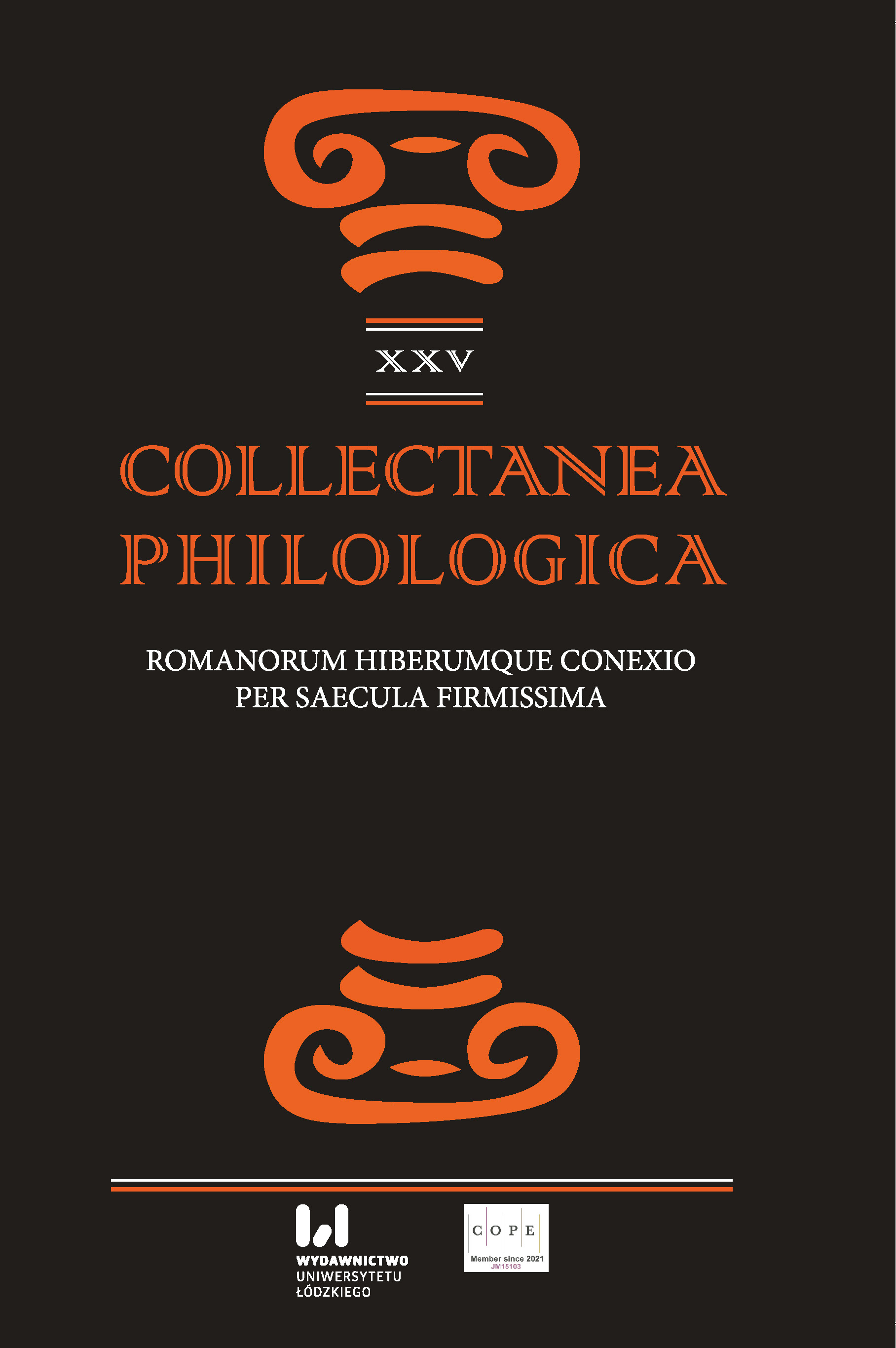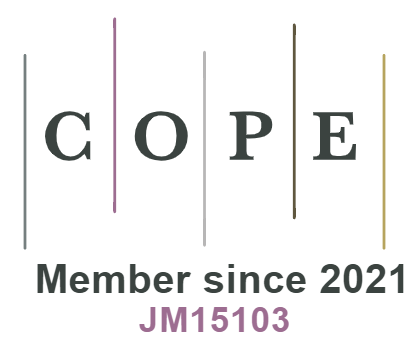Heracles in the Iberian Peninsula
DOI:
https://doi.org/10.18778/1733-0319.25.02Słowa kluczowe:
Herakles, Herkules, Półwysep Iberyjski, mit, Gerion, HiszpaniaAbstrakt
The story of Herculesʼ achievements, like many others in Greek mythology, has undergone various changes since Hesiodʼs early transmissions helped to consolidate the essential elements of the myth and its characteristics. With the translocation of myths from Caucasian Iberia to Western Iberia, certain places, characters and events associated with the land were also transferred. The Fortunate Islands, the Garden of Hesperides, the place of the 10th and 11th labours of Hercules have been relocated, and the origin and meaning of the pillars set up by the hero have been identified and interpreted. The aim of this article is to show how one of these myths, namely that of Hercules and Geryon, was shaped in the classical and later periods. The transformation of three elements of this myth will be analysed: its location, the figure of Geryon and the description of Herculesʼ achievements.
Bibliografia
Aelian. (1858). Aeliani De natura animalium. Varia historia, epistolae et fragmenta; Porphyri Philosophi De abstinentia et De antro nympharum; Philonis Byzantii De septem orbis spectaculis. Recognovit adnotatione critica et indicibus instruxit R. Hercher. Parisiis.
Google Scholar
Aeschylus. (1997). The Oresteia (Agamemnon, The Libation Bearers, The Eumenides). Translated by Vellacott, P. The Penguin Classics. London: Penguin Books.
Google Scholar
Ammianus Marcellinus. (1950). History. Volume I. Translated by J.C. Rolfe. Loeb Classical Library. Cambridge, MA: Harvard University Press.
Google Scholar
Apollodorus. (1921). The Library. English Translation by Sir J.G. Frazer. F.B.A., F.R.S. in 2 Volumes. Cambridge, MA: Harvard University Press; London: William Heinemann Ltd.
Google Scholar
Diodorus Siculus. (1888–1890). Bibliotheca Historica. Vol. 1–2. Ed. Immanel Bekker. Ludwig Dindorf. Friedrich Vogel. Leipzig: B. G. Teubner.
Google Scholar
Diodorus Siculus. (1935). Library of History. Translated by Oldfather. C.H. Loeb Classical Library Volumes. Cambridge, MA: Harvard University Press.
Google Scholar
Euripides. (1913). Euripidis Fabulae. Vol. 2. Gilbert Murray. Oxford: Clarendon Press.
Google Scholar
Euripides. (2006). Orestes and other plays. Translated by P. Vellacott. The Penguin Classics. London: Penguin Books.
Google Scholar
Herodotus. (1920). Herodotus. Ed. A.D. Godley. Cambridge, MA: Harvard University Press.
Google Scholar
Hesiod. (1914). The Homeric Hymns, Epic Cycle, Homerica. Translated by H.G. Evelyn-White.Loeb Classical Library. Cambridge, MA: Harvard University Press.
Google Scholar
Horace. (1882). The Odes and Carmen Saeculare of Horace. Translated by J. Conington. London: George Bell and Sons.
Google Scholar
Hyginus. (1967). Hygini Fabulae. Recensuit, Prolegomenis Commentario Appendice instruxit H.I. Rose, Lugduni Batavorum apud A.W. Sijthoff 1934.
Google Scholar
Isidorus Hispalensis, Etymologiarum sive originum libri XX. http://www.thelatinlibrary.com/isidore.html (30.06.2022).
Google Scholar
Lucretius. (1924). On the Nature of Things. Translated by W.H.D. Rouse. Revised by Martin F. Smith. Loeb Classical Library. Cambridge, MA: Harvard University Press.
Google Scholar
Orosius. http://www.attalus.org/latin/orosius.html (30.06.2022).
Google Scholar
Ovid. (2009). Metamorphoses. Translated by A.D. Melville. Oxford: Oxford University Press.
Google Scholar
Pausanias. (1903). Pausaniae Graeciae Descriptio. 3 Vols. Leipzig: Teubner.
Google Scholar
Pausanias. (2014). Description of Greece. Translated by W.H.S. Jones. Loeb Classical Library. Cambridge, MA: Harvard University Press. https://doi.org/10.4159/DLCL.pausanias-description_greece.1918.
Google Scholar
DOI: https://doi.org/10.4159/DLCL.pausanias-description_greece.1918
Pindar. (1997). Nemean Odes. Isthmian Odes. Fragments. Edited and translated by W.H. Race. Loeb Classical Library. Cambridge, MA: Harvard University Press. https://doi.org/10.4159/DLCL.pindar-isthmian_odes.1997
Google Scholar
DOI: https://doi.org/10.4159/DLCL.pindar-isthmian_odes.1997
Plato. (1903). Platonis Opera. Ed. John Burnet. Oxford: Oxford University Press.
Google Scholar
Pliny. (1938). Natural History. Volume I: Books 1–2. Translated by H. Rackham. Loeb Classical Library. Cambridge, MA: Harvard University Press.
Google Scholar
Plutarch. (1914). Plutarchʼs Lives. Translated by B. Perrin. Loeb Classical Library. Cambridge, MA: Harvard University Press.
Google Scholar
DOI: https://doi.org/10.4159/DLCL.plutarch-lives_numa.1914
Pomponius Mela. (1971). Pomponii Melae De Chorgraphia Libri Tres una cum Indice Verborum. Ed. G. Ranstrand. Stockholm: Almqvist & Wiksell.
Google Scholar
Pomponius Mela. (1998). Pomponius Melaʼs description of the world. Ed. F.E. (Frank E.) Romer. Ann Arbor: University of Michigan Press.
Google Scholar
Seneca L.A. (1978). Hercules furens; Trojanerinnen = Troades; Medea; Phaedra; Octavia = Octavia praetexta incerti poetae, übers. und erl. von Theodor Thomann. Zürich, München.
Google Scholar
Servius Honoratus M. (1999). Commentary on the Aeneid of Vergil. Ed. Georgius Thilo. http://www.perseus.tufts.edu/hopper/text?doc=Serv.+A.+8.300&fromdoc=Perseus%3Atext%3A1999.02.0053 (30.06.2022).
Google Scholar
Solinus. (1895). De mirabilibus mundi. Mommsen 2nd edition. https://www.thelatinlibrary.com/solinus.html (30.06.2022).
Google Scholar
Stesichorus. (1924). Geryoneis. In: Strabo. (1924). The Geography of Strabo. Ed. H.L. Jones. Cambridge, MA: Harvard University Press; London: William Heinemann, Ltd.
Google Scholar
Strabo. (1924). The Geography of Strabo. Ed. H.L. Jones. Cambridge, MA: Harvard University Press; London: William Heinemann, Ltd.
Google Scholar
Vergilius. Aeneid. http://www.thelatinlibrary.com/verg.html (30.06.2022).
Google Scholar
Banach, J. (1984). Hercules Polonus. Studium z ikonografii sztuki nowożytnej. Warszawa: Państwowe Wydawnictwo Naukowe.
Google Scholar
Barbarzak, D. (2019). “Herkules i Gerion, królowie Hiszpanii. Mit i jego recepcja w iberyjskich kronikach dobry średniowiecza i nowożytności”. Symbolae Philologorum Posnaniensium Graecae Et Latinae 28(2). 89–125. https://doi.org/10.14746/sppgl.2018.XXVIII.2.7
Google Scholar
DOI: https://doi.org/10.14746/sppgl.2018.XXVIII.2.7
Blanco Robles, F. (2019). “La recepción del mito de Hércules y Gerión en las Crónicas Medivales Hispanas”. Estudios Humanisticos. Filologia 41. 135–151. https://doi.org/10.18002/ehf.v0i41.5940
Google Scholar
DOI: https://doi.org/10.18002/ehf.v0i41.5940
Blázquez Martínez, J.M. (1983). “Gerión y otros mitos griegos en Occidente”. Gerión. Revista de Historia Antigua 1. 21–38.
Google Scholar
Boczkowska, A. (1993). Herkules i Dawid z rodu Jagiellonów. Warszawa: Arx Regia, Ośrodek Wydawniczy Zamku Królewskiego w Warszawie.
Google Scholar
Camacho, P.F. (2013a). ‟Gádeira, el décimo trabajo de Heracles y la política de Atenas”. Euphrosyne 41. 9–30.
Google Scholar
DOI: https://doi.org/10.1484/J.EUPHR.5.125038
Camacho, P.F. (2013b). ‟Cádiz entre Europa y África: Una paradoja geográfica”. HABIS 44. 323–335. http://dx.doi.org/10.12795/Habis.2013.i44.18.
Google Scholar
Camacho, P.F. (2015a). ‟The Island Erytheia: A Clash of Disciplines”. European Scientific Journal, ESJ, 11(3). https://eujournal.org/index.php/esj/article/view/5078 (30.06.2022).
Google Scholar
Camacho, P.F. (2015b). “A Space without Ethnology: Study of the Ideological Treatment of the West in Greek and Roman Literature through the Sources about the Island of Gadesˮ. L’Antiquité Classique, 84, 63–73. https://www.jstor.org/stable/90005006 (30.06.2022).
Google Scholar
DOI: https://doi.org/10.3406/antiq.2015.3865
Corzo Sánchez, J.R. (2005). “Sobre las primeras imágenes y la personalidad originaria de Hercules Gaditanus”, SPAL 14. 91–122. https://dx.doi.org/10.12795/spal.2005.i14.04
Google Scholar
DOI: https://doi.org/10.12795/spal.2005.i14.04
Czerwińska, J. (2006). “Hercules furens: Eurypidejska przypowieść o ludzkim szaleństwie”. Collectanea Philologica 9. 87–111.
Google Scholar
Danielewicz, J. (1984). Wstęp. In: Liryka starożytnej Grecji. Wrocław, Warszawa, Kraków, Gdańsk, Łódź.
Google Scholar
De Sanctis, D. (2011). “Quando Eracle giunse a Erythia. Gerione in Esiodo, Stesicoro ed Acateo”. SCO 57. 57–72. https://datospdf.com/download/quando-eracle-giunsea-erythia-gerione-in-esiodo-stesicoro-ed-ecateo-_5a4c0ef1b7d7bcb74fded61d_pdf (30.06.2022).
Google Scholar
Domínguez Monedero, A.J. (1983). “Los términos Iberia e íberos en las fuentes grecolatinas. Estudio acerca de su origen y ámbito de aplicación”. Lucentum 2. 203–224.
Google Scholar
DOI: https://doi.org/10.14198/LVCENTVM1983.2.10
Gómez Espelosín, F.J. et al. (1995). La imagen de España en la Antigüedad clásica. Madrid: Editorial Gredos.
Google Scholar
González García, F.J. (1997–1998). Hércules contra Gerión. Mitos y leyendas de la Torre de Hércules. Vol. II. Oleiros: A Coruña: Vía Láctea: Ayuntamiento de La Coruña.
Google Scholar
Hernández de la Fuente, D. (2012). Herkules w Hiszpanii: szkic o mitologii i symbolizmie. In: M. Cieśla-Korytowska, O. Płaszczewska (eds.). Prace Herkulesa – człowiek wobec wyzwań, prób i przeciwności. Kraków: Wydawnictwo Uniwersytetu Jagiellońskiego.
Google Scholar
Lomas Salmonte, F.J. (2005). Historia de Cádiz. Madrid: SILEX EDICIONES.
Google Scholar
Oria Segura, M. (1996). Hércules en Hispania: una aproximación. Barcelona: Promociones y Publicaciones Universitarias, PPU.
Google Scholar
Pietrzak-Thébault, J. (2012). Herkules na rozdrożu – między ideałem rycerza a ‘męża szlachetnego’ i monarchy nowych czasów. In: M. Cieśla-Korytowska, O. Płaszczewska (eds.). Prace Herkulesa – człowiek wobec wyzwań, prób i przeciwności. Kraków: Wydawnictwo Uniwersytetu Jagiellońskiego.
Google Scholar
Plácido, D. (1990). Le vie di Ercole nellʼestremo Occidente. In: A. Mastronique (ed.). Ercole in Occidente. Atti del colloquio internazionale. Trento 7 marzo 1990. Trento: Università degli studi di Trento. 63–80.
Google Scholar
Szarypkin, S. (2011). Wstęp. In: Pomponiusza Meli Chorographia czyli opis okręgu ziemi. Piotrków Trybunalski: Naukowe Wydawnictwo Piotrkowskie.
Google Scholar
Szoka, A.I. (2010). Herkules konkurent Chrystusa: studium na tle zmagań religii pogańskiej z chrześcijaństwem w późnym antyku (do końca IV w.). Kraków: Wydawnictwo Radamsa.
Google Scholar
Vigo Trasancos, A. (2010). “Tras las huellas de Hércules. La torre de Crunna y el Pórtico de la Gloria”. QUINTANA 9. 217–233.
Google Scholar
Wojciechowski, P. (2005). Czciciele Herkulesa w Rzymie. Studium epigraficzno-antropomastyczne (I–IV wiek n.e.). Toruń: Wydawnictwo Naukowe Uniwersytetu Mikołaja Kopernika.
Google Scholar
Pobrania
Opublikowane
Jak cytować
Numer
Dział
Licencja

Utwór dostępny jest na licencji Creative Commons Uznanie autorstwa – Użycie niekomercyjne – Bez utworów zależnych 4.0 Międzynarodowe.












